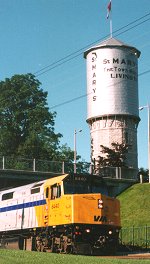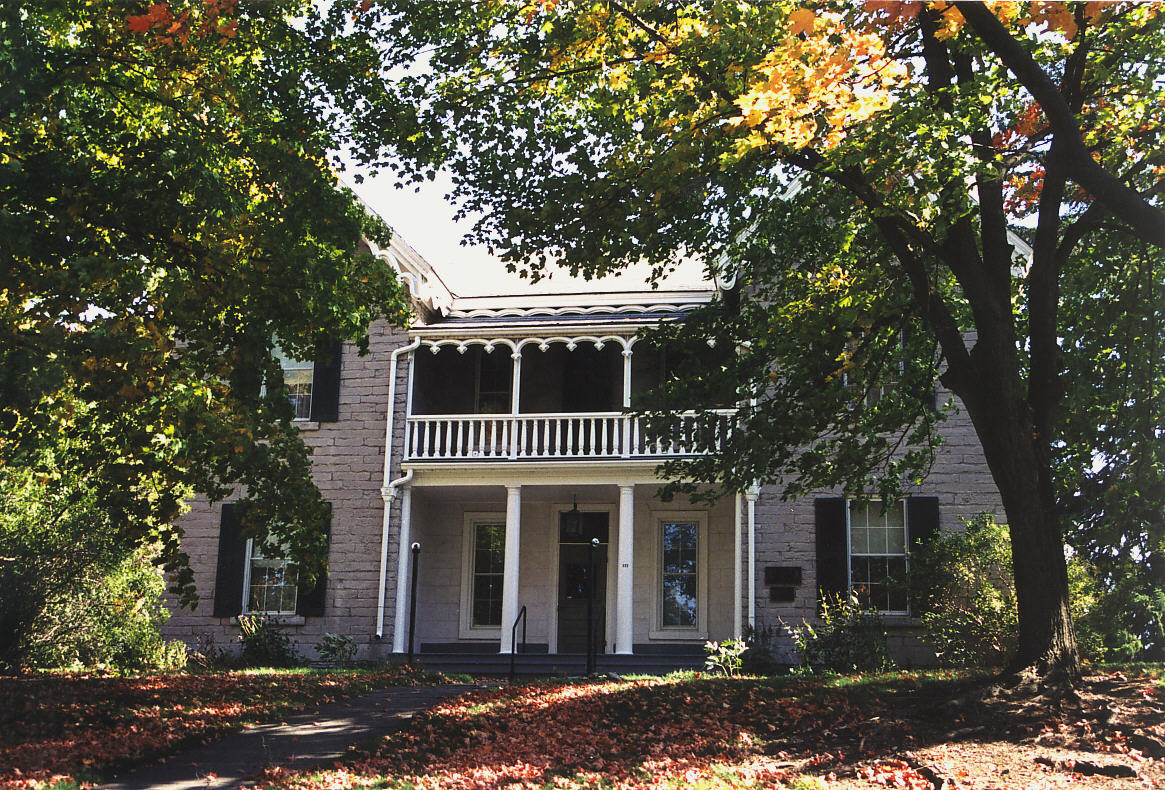Heritage and Historic Landmarks
Contact Us
The "Stonetown" is an apt moniker for St. Marys, as the town is filled with unique architecture featuring locally-quarried limestone. The stone buildings reveal much about the town's history, and in many cases, the development of the town can be witnessed in the architecture. Heritage St. Marys, the local Municipal Heritage Committee, has lead the way in preserving and maintaining the unique stone buildings found in St. Marys. Take some time to wander through the "Stonetown" enjoying the architecture!
Note: Town documents below can be made accessible upon request.
Heritage Properties
The Ontario Heritage Act requires the municipality to keep a register of property that is of cultural heritage value or interest. The register is commonly known as the Municipal Heritage Register (MHR) and includes:
- Property that has been designated under Part IV or Part V of the Ontario Heritage Act; and,
- Property that has been listed as a non-designated property of cultural heritage value or interest.
Designated heritage properties
Designated properties are valued by the community for their architectural, historic and/or contextual significance. The Town has 48 individually designated properties and one Heritage Conservation District (HCD) with over 151 properties.
- Details about the HCD: Heritage Conservation District (HCD) Plan
- Details about individually designated properties: Municipal Register of Designated Heritage Properties
Alterations to these properties are managed by a Heritage Permit Application which ensures their continued conservation.
Non-designated heritage properties
Non-designated properties are those that have cultural heritage value or interest to the community. The Town has over 100 non-designated heritage properties listed in the Municipal Register of Non-designated Heritage Properties.
Owners of non-designated properties are not subject to the heritage permit process or Heritage Committee review, nor are they required to obtain Council approval to make alterations to their properties. However, owners who intend to demolish part or all of any buildings on a non-designated heritage property are legally required to give the Town 60 days' written notice. This notice period allows the Town to make an informed decision about whether long term protection of the property should be sought through the formal designation process. Download our Frequently Asked Questions document for more details.
If you would like to have your property removed from the draft non-designated section of the Municipal Register, please contact the Cultural Services Supervisor. As per the Ontario Heritage Act, Council will confer with the Heritage Committee before a property is removed.
Heritage Property Grant Program
The St. Marys Designated Heritage Property Grant Program is available to owners of heritage designated properties in the Town of St. Marys. The program is designed to assist property owners in the conservation and preservation of the Town's built heritage resources. Eligible properties must be designated under the terms of the Ontario Heritage Act as an individual property or be located within the Heritage Conservation District.
The Heritage Property Grant Program provides a grant of up to 50% of the lowest estimate or up to 50% of the actual cost (whichever is the lesser) of eligible heritage conservation work, to a maximum municipal contribution of up to $2,500 for eligible façade painting or a maximum up to $7,500 for eligible work to architectural elements, subject to available funding. The grant must be matched by an equal contribution by the property owner, or the applicant in cases where the applicant is not the property owner. The property may receive one grant per calendar year.
Grants are awarded on a first come, first served basis each year. For a full description of eligibility criteria and information about how to apply, contact the Cultural Services Manager.
Highlights and Walking Tours
| Junction Station |
 Location: Glass Street Original Owner: Grand Trunk Railway Date of Construction: 1858 The Junction Station was constructed in 1858, under the supervision of the famous Canadian contractor Sir Casmir Gzowski, as a major station on the Toronto to Sarnia Branch of the Grand Trunk Railway. This station is believed to be the only remaining structure in Canada in which the famous inventor Thomas Edison worked while employed with the Grand Trunk. In 1933, the desk which Edison is purported to have worked at was removed from the Station and relocated to the Edison Institute in Dearborn, Michigan. In 1973, the Junction Station was declared to be of national historic and architectural significance by the Historic Sites and Monuments Board. |
| Grand Trunk/VIA Station |
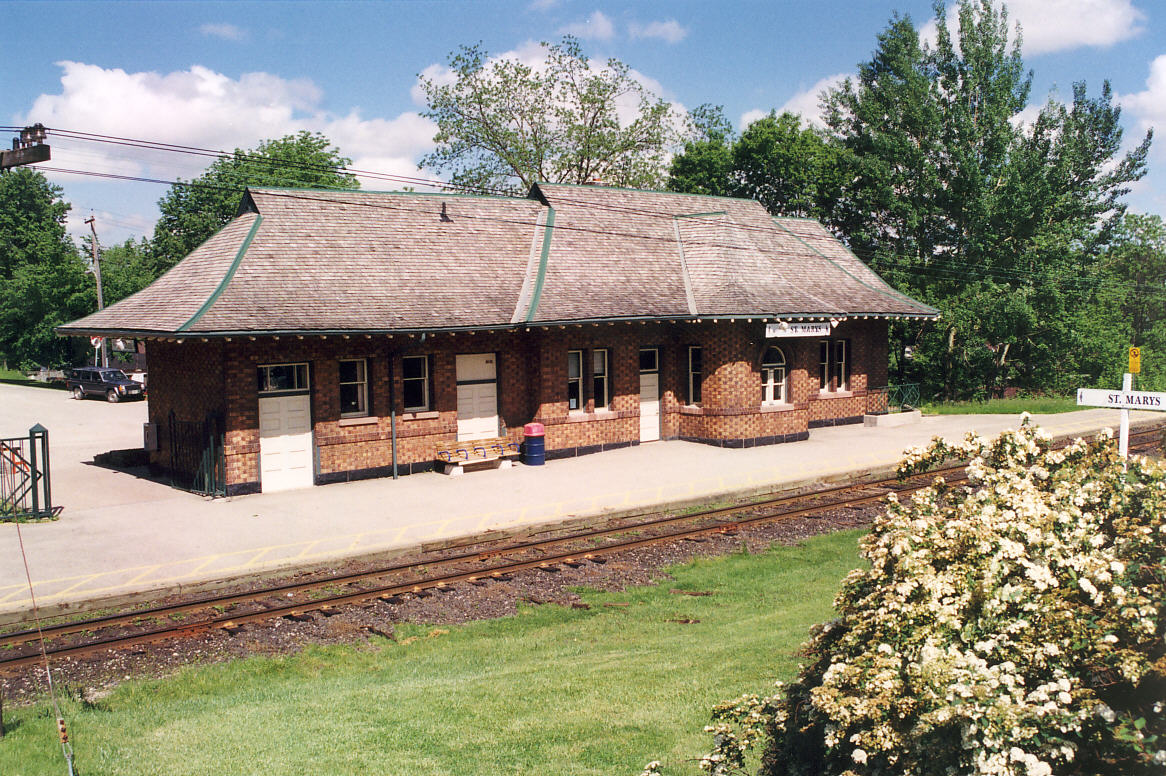 Location: 5 James Street North Original Owner: Grand Trunk Railway Date of Construction: 1907 The Grand Trunk Railway depot was constructed in the summer of 1907, and was the third station on the line at St. Marys. It was built of a glazed brick of brownish tint known as Logan Brick. Originally the depot contained a main waiting room with a ticket and operating room at the rear, men's and women's toilets, a ladies' retiring room, a smoking room for men and an express department located at the north end. The building was of individual design but according to The Argus of July 25, 1907, bore similarities to the Paris depot. |
| Town Hall |
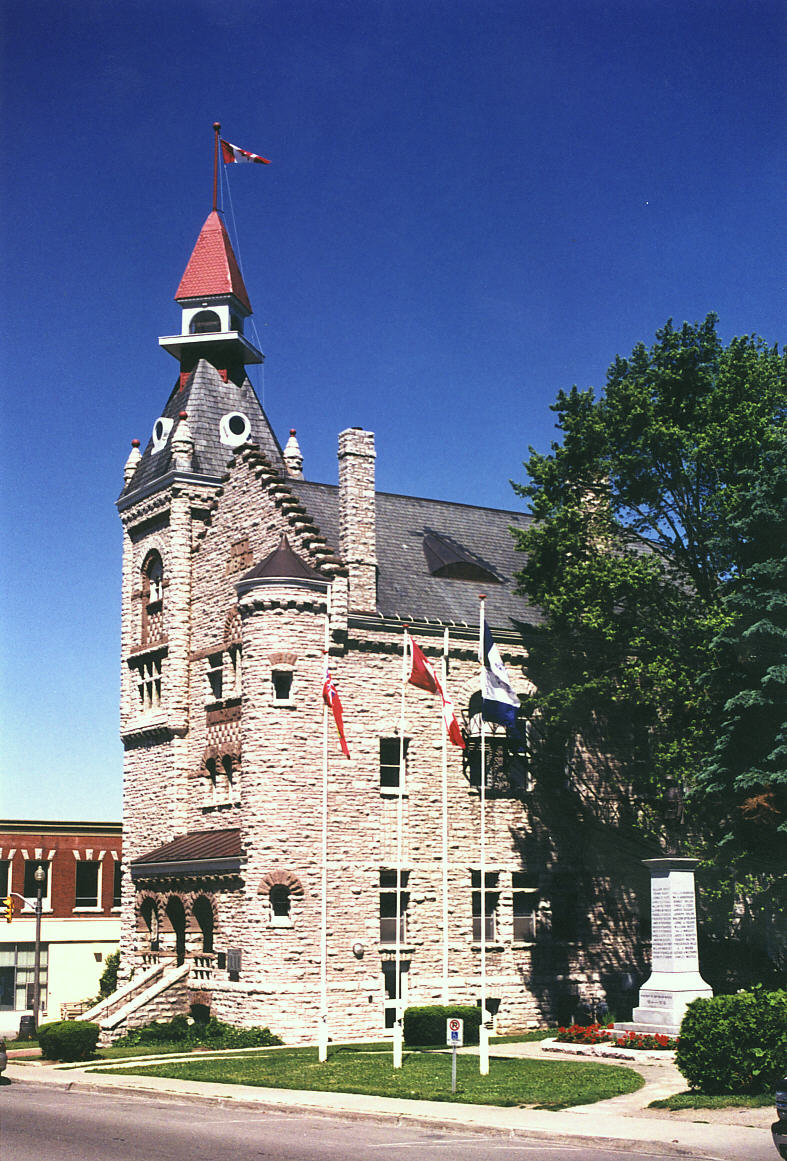 Location: 175 Queen Street East Original Owner: Town of St. Marys Date of Construction: 1891 This Romanesque Revival building, designed by George Wallace Gouinlock, Toronto architect, was built in 1901 of local limestone with red sandstone as the contrasting elements for window arches and checkerboard effects in the façade. The massive entrances on the south and west façades of the building and the two towers on the south, emphasize the wishes of Councilor Mathieson, a member of the building committee, who stated the following: "We should not adopt a florid style of ornamentation, but yet we should not erect a painfully plain building simply because it is cheaper. The ornamentation should be of a lasting and permanent character. We are not building a hall or market for right now, but for years or generations to come. Let us build right." Due to its prominent location on the north side of the main street, and dominating as it does the sky-line of the Town, it plays an important role in the character of the downtown area. |
| Victoria Bridge |
 Location: Queen Street across the Thames River Original Owner: Town of St. Marys Date of Construction: 1865 This pre-confederation stone four-arched structure spanning the Thames River is and has been the most important of the several bridges in the Town. Several log and timber bridges occupied the site until Town Council in August of 1864 authorized the signing of a contract with Alex McDonald "for the construction of a stone arched bridge across the Thames, on Queen Street, according to the plan submitted by Mr.. Niven, P. L. S. - cost $4 450- completion date September 1, 1865." In 1981, Town Council repealed the historic designation of the Victoria Bridge. |
| St. Marys Public Library |
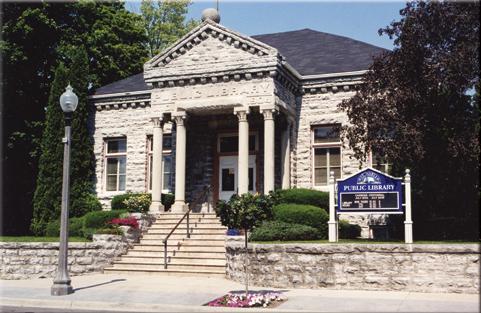 Location: 15 Church Street North Original Owner: St. Marys Public Library Date of Construction: 1904 This building was built in 1904 and 1905 using a $10 000 grant from the Andrew Carnegie Foundation. It was designed following the accepted Carnegie Brick Temple plan, by architect J. A. Humphries. It is built of St. Marys limestone, the work being completed by Robert Clyde, local stonemason. This building was preserved because of its relationship to the Town Hall and its importance to the social development of the Town of St. Marys. |
| Water Tower |
|
|
| Tracy House / St. Marys Museum |
|
|
| The Quarries |
 Location: Water Street South Date of Construction: Mid-1800s The Thames Quarry Company grew out of a number of small, independently owned quarries that had been opened along Water street in the mid - 1800s. Finally, one quarrying company developed and the two pits were joined by a tunnel under Water Street. The quarrying industry began by retrieving blocks of limestone with the use of dynamite, to be used in the construction of buildings. The industry also produced crushed stone and lime as construction needs changed. In 1914 the Thames Quarry Company sought to expand and petitioned the Town of St. Marys to close the Water Street route out of town so that limestone under the road could be extracted. Town council decided Water Street was too important and the proposal was rejected. The Thames Quarry Company ceased operations in 1930, although a stock pile of crushed stone continued to be used years afterward. All useful pieces of machinery including the pumps that had continually pumped the water from the springs out of the pit were removed and the two quarries filled with water. However, railway tracks once used to carry limestone out of the quarry still lie on the bottom. In 1945 the town purchased the quarries along with 50 acres of land for a nominal fee. In 1946 Don Fletcher was hired as lifeguard for the sum of $25 per week. Don's brother Doug ran the concessions and admissions. Either Don or Doug would sleep in the booth to safeguard its contents each night. In 1950 the decision to charge admission was made. Local children could purchase a season's pass for 25 cents. |
| Sarnia Bridge |
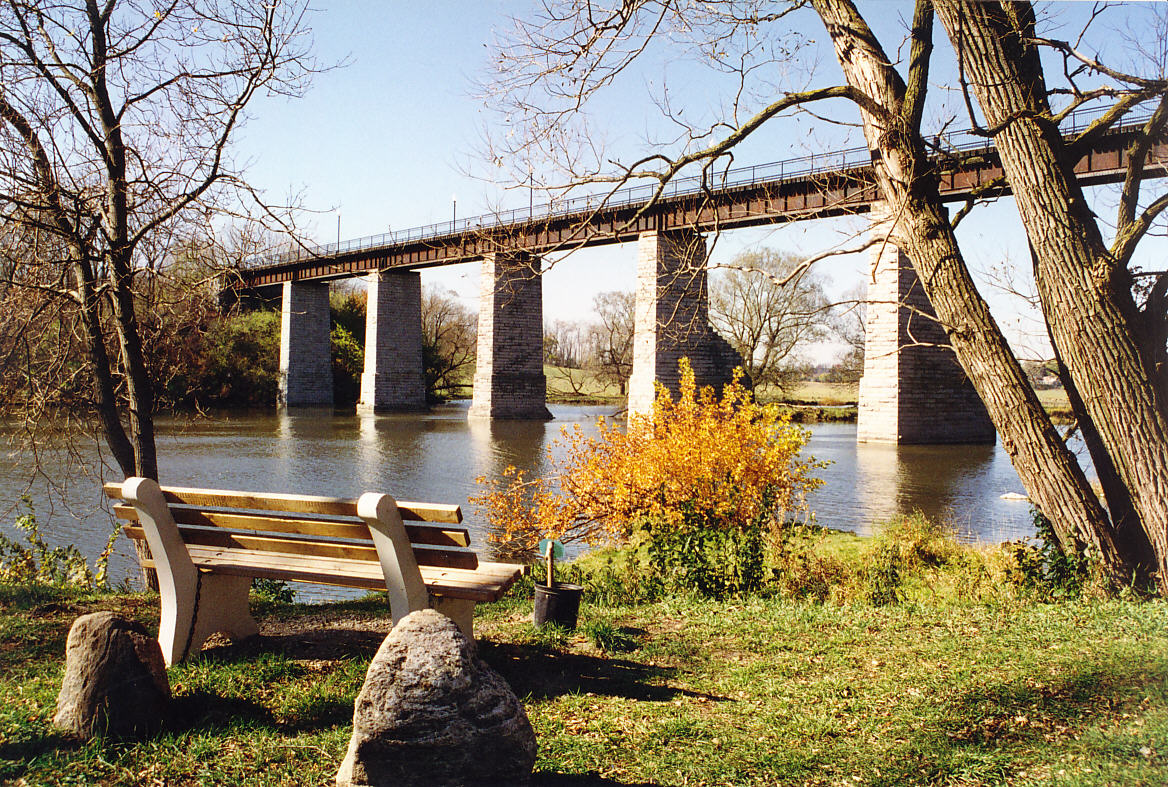 Location: Grand Trunk Trail over the Thames River Date of Construction: 1858 This community walkway started out as part of the historic Grand Trunk Railway. In 1858, the GTR reached the small village of St. Marys from Toronto and points further east. From here, the line went west to Sarnia and then, on the other side of the border, from Port Huron to Chicago. When the railway builders arrived in St. Marys in the mid-1850s, the major challenge for both structural engineers and contractors was the erection of two high railway bridges. One was needed to cross the Thames River. The other took a spur line to London across Trout Creek. Both required a row of massive stone pillars to support the girders and tracks. These immediately became landmarks in St. Marys and are still known as the Sarnia Bridge and the London Bridge. Today, VIA Rail continues to operate the line to London. However, it abandoned the line to Sarnia in 1989, placing the future of the wonderful Sarnia Bridge in doubt. In 1995, the Town of St. Marys was able to purchase the Sarnia Bridge from the Canadian National Railway, as well as the right of way within Town limits along the abandoned line. A citizens' committee was formed in June, 1996, to work towards transforming this old railway line into a trail for everyone to enjoy - residents and visitors alike. |
| James Carter House |
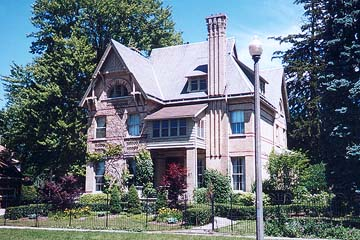 Location: 67 Peel Street South Original Owner: James Carter Date of Construction: 1883 The James Carter House is one of four mansions built at the expense of George Carter for himself and members of his family. By 1868, George Carter had acquired the town block bounded by Jones, Peel, Elgin and King Streets and intended to build several homes for his family on this land. George Carter's first home (the present 224 Jones Street East) was built as the "home place" in 1869; the house at 217 Jones Street East was erected around 1875 for his daughter Harriet and her husband Clarence Freeman; in 1881, the house at 236 Jones Street East was built for Charlotte Carter and her husband H. L. Rice; the fourth mansion at 67 Peel Street South was built for James Carter and his wife Mary Box in 1883. This family compound of four grand houses erected within a space of fifteen years owes its existence to the prosperity of the St. Marys' grain market in the 1860s and 1870s, and of George Carter's ability to capture that market. The James Carter house is the most advanced building of its time in St. Marys; with its elaborate detailing, the house would easily have been at home in the City of Toronto during the same period. This building is attributed stylistically to William Williams, the St. Marys Town Clerk during the 1880s and the designer of our provincial structures of that period. |
Fully accessible versions of all above documents are available in print upon request.










